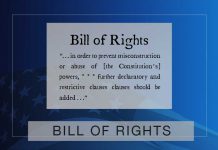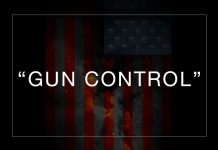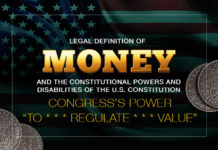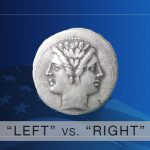Last Updated on October 3, 2021 by Constitutional Militia
During the hearings on the confirmation of President Trump’s nominee to the Supreme Court, Circuit Judge Neil Gorsuch, Senator Dianne Feinstein asked two questions of great interest to me, because they dealt with the Second Amendment in its relation to so-called “assault rifles” (that is, rifles available for use by civilians which are similar in most of their features to the rifles carried by the regular Armed Forces, except for being only semi-automatic, rather than fully automatic, in their mechanisms of fire). Unfortunately, these questions and their answers proved once again that hearings of this kind tend to be pointless charades, because the nominees inevitably craft their answers in such artful fashion as to say as little as possible that would pin down their true positions on the matters under investigation. I should think that such a lack of candor towards the very institution—the Senate of the United States—in which the Constitution vests the authority to give “Advice and Consent” with respect to nominations of “Judges of the supreme Court” suggests that a nominee is deficient in the sort of “good Behaviour” which a “Judge[ ] * * * of the supreme * * * Court[ ]” must demonstrate during his tenure on the Court, and therefore that such a nominee is arguably of questionable fitness for that position. See U.S. Const. art. II, § 2, cl. 2; art. III, § 1. For if a nominee conducts himself in a manner as slippery as transmission-fluid when under oath in his testimony to the Senate—and, by extension, to the American people—one might justifiably expect him to be no less slippery in the opinions he will enunciate once safely ensconced on the Bench.
So in this commentary I shall provide some “alternative history”, in the form of the answers to these questions which should have been given by a completely candid and thoroughly knowledgeable nominee who was actually intent on enforcing the Constitution in general and the Second Amendment in particular, and who was sufficiently forthright to make that intent known, the consequences to his ambition be damned. (As to the actual colloquies between Senator Feinstein and Judge Gorsuch, I shall rely on the text reported by Kelsey Harkness, “Gorsuch Faces Questions About Supreme Court and Guns” (21 March 2017), at dailysignal.com.)
QUESTION AND ANSWER I, AS GIVEN.
Senator Feinstein: In D[istrict of] C[olumbia] v. Heller, [554 U.S. 570 (2008)], the majority opinion written by Justice Scalia recognized that * * * “Of course the Second Amendment was not unlimited” * * * . Justice Scalia also wrote that, “Weapons that are more useful in military service, M-16 rifles and the like, may be banned without infringing on the Second Amendment.” Do you agree with that statement that under the Second Amendment weapons that are most useful in military service * * * may be banned?
Judge Gorsuch: Heller makes clear the standard that we judges are supposed to apply. The question is whether it is a gun in common use for self-defense, and that may be subject to reasonable regulation. That’s the test as I understand it.
ANSWER I, AS IT SHOULD HAVE BEEN GIVEN.
Judge Candorfull: I disagree, for the following reasons:
- First, the assumption in the question that Heller actually held that “[w]eapons that are most useful in military service, M-16 rifles and the like, may be banned” without infringing on the Second Amendment is incorrect. No “[w]eapons that are most useful in military service, M-16 rifles and the like” were involved in Heller. And the use to which the firearm actually involved in Heller—a handgun—was to be put was personal protection in the home, not “military service” of any sort. So what Justice Scalia incautiously wrote concerning “M-16 rifles and the like” was mere dicta, with no legal force as any sort of “precedent” which could set any “standard” the Judiciary needs to apply.
- Second, the Second Amendment’s stated goal is not an individual’s personal protection in the home with a handgun, but instead “the security of a free State”. The Amendment declares “[a] well regulated Militia” to be “necessary” for that purpose. And to guarantee that such a Militia always exists in every one of the several States, it commands that “the right of the people to keep and bear Arms, shall not be infringed.” Howsoever that “right” embraces “Arms” convenient for an individual’s self-defense in his home, it unquestionably protects all “Arms” useful for “the people[’s]” collective defense of “a free State” through the efforts of “well regulated Militia”. That is the Amendment’s central concern—quite explicit and perfectly understandable.
As to what particular types of “Arms” it protects, the Second Amendment must be construed “in the light of the law as it existed at the time it was adopted”. See Mattox v. United States, 156 U.S. 237, 243 (1895). Throughout the 1700s, all Americans knew that “a well regulated militia[ is] composed of the body of the people, trained to arms”. Virginia Declaration of Rights (1776) art. 13. Every “well regulated Militia” was a military or para-military establishment, in which the “arms” at issue were equivalent to (and sometimes even better than) the “arms” carried by members of the regular Armed Forces who performed similar duties. See, e.g.,The Selective Service System, Military Obligation: The American Tradition, Special Monograph No. 1 (1947). Today, the “arms” most suitable for that purpose in the hands of ordinary civilians would be at least semi-automatic “assault rifles”. Thus it follows, not only that such rifles cannot be “banned”, but in addition that they deserve a very high, if not the highest level of protection available under the Second Amendment.
• Third, as to the question of “common use for self-defense”, it must be recalled that during the pre-constitutional era, when the principles of “[a] well regulated Militia” embodied in the Constitution were established, all of the “arms” militiamen (that is, common citizens) possessed were of the kind in common use, because just about all firearms then available were suitable for Militia service, as well as for individual self-defense. In various localities, surplus British army muskets were common, and captured French army muskets not common (or vice versa); or smooth-bored muskets were more common than rifled muskets (or vice versa); or the only common firearms were whatever militiamen happened to have at hand. But these differences the Militia statutes accepted as consistent with “well regulated Militia”. So all of those firearms were, as a matter of law, in common use because they all were being used for a common purpose. Therefore, because “assault rifles” in the hands of individuals eligible for Militia service (which includes the vast majority of able-bodied adult citizens) would arguably be the most suitable firearms for contemporary “well regulated Militia”, they would be in common use for that purpose, no matter how many Americans happened to possess them. And that purpose being the central concern of the Second Amendment, possession of such rifles would be protected to the highest degree possible.
• Fourth and last, as to “reasonable regulation”, some people put forward all sorts of reasons why possession of “[w]eapons that are most useful in military service, M-16 rifles and the like”—or even possession of all firearms—should be restricted to members of the Armed Forces and professional para-militarized police forces. If one accepted those reasons as being to some degree rational (as opposed to being obvious manifestations of mental illness), then someone’s “reasonable regulation” could always be found sufficient to reduce “the right of the people to keep and bear Arms” to a nullity. The constitutional standard, however, is not just anyone’s theory of “reasonable regulation”. Instead, the Second Amendment uniquely defines the one and only “reasonable regulation” in this field: namely, that “the right of the people to keep and bear Arms”—of whatever kinds serve the Amendment’s central purpose—“shall not be infringed”. The central purpose of the Amendment is to ensure “the security of a free State”. In “a free State” the people are sovereign. The sovereign is the supreme political power. In the final analysis, then, political power in “a free State” reduces to the collective ability of the citizenry to wield overwhelming force against any threats to the security of their community—which under modern conditions can be summed up in the aphorism “political power grows out of the barrel of a gun” suitable for community self-defense in each citizen’s own hands. Any proposed regulation which would prohibit a law-abiding citizen from possession of any firearm useful in his hands for provision of “the security of a free State” would be unreasonable, by constitutional definition.
QUESTION AND ANSWER II, AS GIVEN.
Senator Feinstein: Do you agree with [Chief] Judge Wilkinson [in his concurring opinion in Kolbe v. Hogan, No. 14-1945 (4th Cir., 21 February 2017)] that the Second Amendment is ambiguous? Should the ambiguity be decided by the court or legislatures?
Judge Gorsuch: I would begin by saying, I hold Judge Wilkinson in high regard. He’s a very fine man and a very fine judge.
* * * * *
The Supreme Court of the United States isn’t final because it is infallible * * * , it is infallible because it is final. And Judge Wilkinson had his view, and the Supreme Court has spoken. And Heller is the law of the land * * * .
Judge Candorfull: Judge Wilkinson actually wrote that he was “unable to draw from the profound ambiguities of the Second Amendment an invitation to courts to preempt this most volatile of political subjects and arrogate to themselves decisions that have historically been assigned to other, more democratic, actors”—that is, legislators and executive officials. I cannot condone that observation, for the following reasons:
• First, if the Second Amendment did suffer from such “profound ambiguities” that the Judiciary were incapable of construing it in such a manner as to clarify and thus obviate those “ambiguities”, it would not be a “law” at all, because all actual “laws” must be understandable. Moreover, if the Amendment did harbor a debilitating set of “profound ambiguities”, how would “other, more democratic, actors” be any better qualified than judges to ferret out some unknowable meaning from such a supposed pastiche of confusion and uncertainty?
In this regard it should be noted that the Maryland statute which banned “assault rifles”, and which the Court of Appeals sustained in Kolbe, specifically excluded from its coverage “the M1 Garand”. See Code of Maryland, Criminal Law § 4-301(b), and Public Safety, § 5-101(r)(2)(xxxvii). This, of course, is the very rifle which no less an authority than General George S. Patton praised as “the greatest battle implement ever devised”. See Julian S. Hatcher, The Book of the Garand (Buford, Georgia: Canton Street Press, Reprint Edition of the 1948 Edition, 2012), at 153. That Maryland’s legislators could be this myopic about such an iconic rifle refutes Chief Judge Wilkinson’s view that “other, more democratic, actors” are competent to draw respectable conclusions about the scope of the Second Amendment.
• Second, inasmuch as the Second Amendment limits the powers of both the General Government and the States, if it contained any “ambiguities” at all then those “ambiguities” should be resolved in favor of “the right of the people to keep and bear Arms”, not in aid of obvious infringements on that “right”. If legislators or executive officials were authorized to determine the extent of “the right of the people to keep and bear Arms”, then by constitutional hypothesis that “right” would be no “right” at all, but only a defeasible license to be limited or even set aside entirely at the legislators’ or officials’ discretion. Legislative or executive inroads on the supposed “right” would be nothing more than “political questions” which are not for the Judiciary even to entertain, let alone to decide. See Marbury v. Madison, 5 U.S. (1 Cranch) 137, 170 (1803).
We know, however, that where the Second Amendment—or any provision of the Bill of Rights—is concerned, Judge Wilkinson’s appeal to “other, more democratic, actors” is quite out of place. For even what he calls “this most volatile of political subjects” cannot escape constitutional constraints on legislative and executive action. As the Supreme Court held in West Virginia State Board of Education v. Barnette, 319 U.S. 624, 638 (1943), “[t]he very purpose of a Bill of Rights was to withdraw certain subjects from the vicissitudes of political controversy, to place them beyond the reach of majorities and officials and to establish them as legal principles to be applied by the courts. One’s * * * fundamental rights may not be submitted to vote; they depend on the outcome of no elections.” I could go further and assert that “[o]ne’s * * * fundamental rights may not be submitted to vote” even at the level of the Supreme Court. For, as Justice Frankfurter pointed out in his concurring opinion in Graves v. New York ex rel. O’Keefe, 306 U.S. 466, 491-492 (1939), “the ultimate touchstone of constitutionality is the Constitution itself and not what we [Justices of the Supreme Court] have said about it.”
• Third, as I explained in my answer to the first question, no one who reads the Second Amendment in its entirety, and who has studied the history which informs it, can believe that it is ambiguous to any degree, let alone that it suffers from “profound ambiguities” with respect to “the right of the people to keep and bear [those] Arms” within the particular category “assault rifles”. Indeed, a criticism of that kind should call into question either the competence or the bias of whoever offered it.
• Fourth, the reason some people profess to find “ambiguities” in the Second Amendment is not because of the Amendment itself, but instead because of Heller. All three of the opinions in that case (one by the majority, two by the dissenters) are ambiguous, because not one of them construes the Amendment, or its relationship with the original Constitution, properly. Indeed, by its disregard of the controlling nature of the Amendment’s first thirteen words, even the majority opinion violates the very first rule of constitutional adjudication, that “[i]t cannot be presumed that any clause of the constitution is intended to be without effect”, and that “effect must be given to each word of the Constitution”. Marbury v. Madison, 5 U.S. (1 Cranch) 137, 174 (1803) and Knowlton v. Moore, 178 U.S. 41, 87 (1900). Accord, e.g., Williams v. United States, 289 U.S. 553, 572-573 (1933); Blake v. McClung, 172 U.S. 239, 261 (1898). Moreover, the majority opinion did not take into sufficient account the Court’s earlier—and entirely unambiguous, even pellucid—opinion in United States v. Miller, 307 U.S. 174 (1939).
Heller certainly proves that the Supreme Court is far from infallible when it comes to deciding questions arising under the Second Amendment—something well known to students of jurisprudence with respect to all sorts of other constitutional questions with which the Court has unsuccessfully struggled in the past. See Payne v. Tennessee, 501 U.S. 808, 828-830 & note 1 (1991). And if Heller is “the law of the case” as to the parties and the issue actually before the Court there, it is not “the law of the land” in the sense of being the final word on the Second Amendment for all other parties and issues. Or even as to the issue it did decide: For it is subject to being overruled, disavowed, qualified, questioned, critically explained, or otherwise distinguished at any time by the Court. That Judge Wilkinson relied upon a seriously skewed interpretation of Heller in Kolbe v. Hogan does not render the Circuit Court’s decision in that case immune from criticism. One cannot arrive at a correct construction of the Second Amendment by misreading an opinion of the Supreme Court which is itself incomplete and misleading.
• Fifth and last, if one wants to avoid “the profound ambiguities” which Judge Wilkinson imagines lurk in the Second Amendment, he should consult: (i) Article I, § 8, cls. 12 through 16 and Article II, § 2, cl. 1 of the original Constitution; (ii) Article VI, [¶ 4] of the Articles of Confederation; and (iii) the pre-constitutional Militia statutes of the Colonies and independent States which establish what “[a] well regulated Militia” is. When all of these materials are treated as parts of a single coherent constitutional structure, the meaning of the Second Amendment becomes obvious.
©2017 Edwin Vieira, Jr. – All Rights Reserved.




































